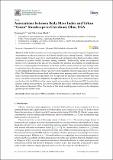| dc.contributor.author | Li, Xiaojiang | |
| dc.contributor.author | Ghosh, Debarchana | |
| dc.date.accessioned | 2018-10-25T15:34:44Z | |
| dc.date.available | 2018-10-25T15:34:44Z | |
| dc.date.issued | 2018-10 | |
| dc.date.submitted | 2018-09 | |
| dc.identifier.issn | 1660-4601 | |
| dc.identifier.uri | http://hdl.handle.net/1721.1/118773 | |
| dc.description.abstract | Public health researchers are increasingly interested in assessing the impact of neighborhood environment on physical activities and chronic health issues among humans. Walkable streets and proximity to green space have long been believed to promote active lifestyles in cities, which contribute to positive health outcomes among residents. Traditionally, urban environmental metrics were calculated at the area level to describe the physical environment of neighborhoods. However, considering the fact that streets are the basic unit for human activities in cities, it is important to understand how the streetscape environment can influence human health conditions. In this study, we investigated the influence of street greenery and walkability on body mass index in Cleveland, Ohio, USA. Different from the area level and overhead view greenery metrics, we used the green view index calculated from the Google Street View to represent the amount of street greenery. The Walk Score was used to indicate the walkability of neighborhoods also at the street level. Statistical analysis results show that the Walk Score has a more significant association with decreased BMI for males than females and the street greenery has a more significant association with decreased BMI for females than males in Cleveland, Ohio. The results of this study would provide a reference for designing gender-specific healthy cities. Keywords: Body mass index (BMI); walkability; street greenery; Google Street View | en_US |
| dc.description.sponsorship | National Institutes of Health (U.S.) (Grant K01DA037794) | en_US |
| dc.publisher | Multidisciplinary Digital Publishing Institute (MDPI) | en_US |
| dc.relation.isversionof | http://dx.doi.org/10.3390/ijerph15102186 | en_US |
| dc.rights | Creative Commons Attribution | en_US |
| dc.rights.uri | http://creativecommons.org/licenses/by/4.0/ | en_US |
| dc.source | Multidisciplinary Digital Publishing Institute | en_US |
| dc.title | Associations between Body Mass Index and Urban “Green” Streetscape in Cleveland, Ohio, USA | en_US |
| dc.type | Article | en_US |
| dc.identifier.citation | Li, Xiaojiang and Debarchana Ghosh. "Associations between Body Mass Index and Urban “Green” Streetscape in Cleveland, Ohio, USA." International Journal of Environmental Research and Public Health 15, 10 (October 2018): 2186 © 2018 The Authors | en_US |
| dc.contributor.department | Massachusetts Institute of Technology. Department of Urban Studies and Planning | en_US |
| dc.contributor.mitauthor | Li, Xiaojiang | |
| dc.relation.journal | International Journal of Environmental Research and Public Health | en_US |
| dc.eprint.version | Final published version | en_US |
| dc.type.uri | http://purl.org/eprint/type/JournalArticle | en_US |
| eprint.status | http://purl.org/eprint/status/PeerReviewed | en_US |
| dc.date.updated | 2018-10-24T08:16:06Z | |
| dspace.orderedauthors | Li, Xiaojiang; Ghosh, Debarchana | en_US |
| dspace.embargo.terms | N | en_US |
| mit.license | PUBLISHER_CC | en_US |
